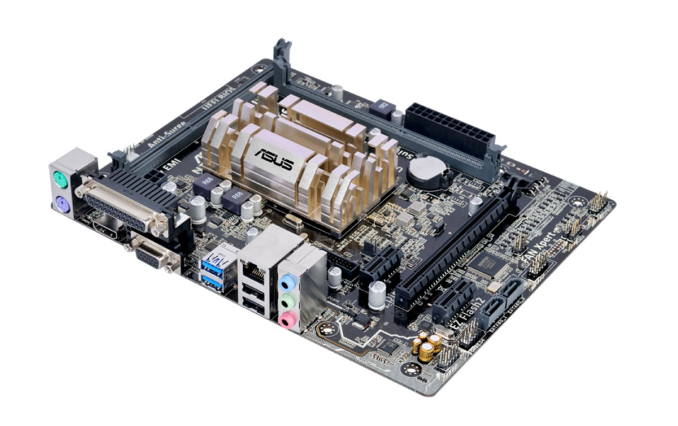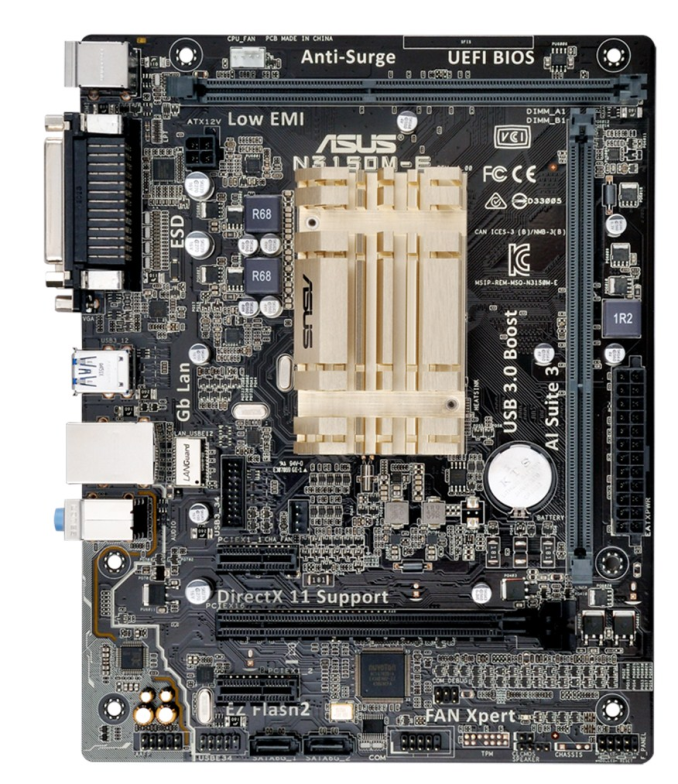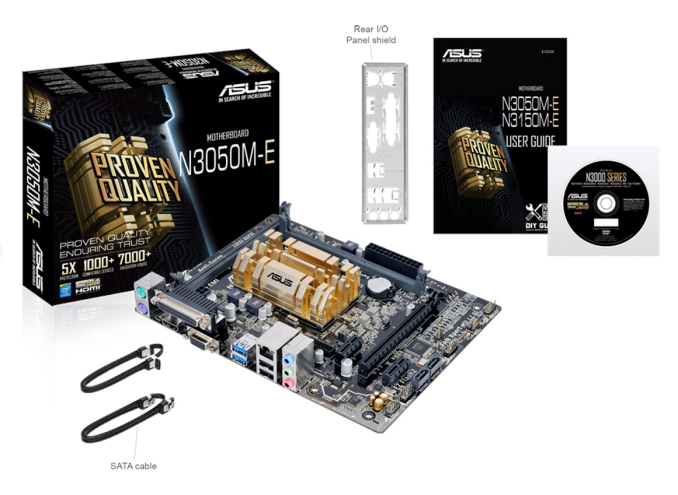Braswell Motherboard Surfaces Online: Quad Core 14nm Airmont in ASUS N3150M-E
by Ian Cutress on May 18, 2015 12:20 PM EST- Posted in
- Motherboards
- Asus
- MicroATX
- Airmont
- Braswell

When Intel initially released its Airmont platforms, Braswell for mini-PCs and Cherry Trail for tablets, it was unclear whether or not we would see custom desktop build equivalents, rather than just pre-built units. All the SoCs in the Braswell range were officially labelled as mobile parts, falling under the Celeron codename, for this reason. Intel has also recently released Xeon D, tackling the SFF space for enterprise use, but in the back of our minds we were always expecting an upgrade to the low-end Bay Trail motherboards with soldered down processors. Having already heard some news on the grapevine, ASUS is first to publicly display their motherboards online (well, one at first), albeit with no link through the main site and as a result this link was passed on to us by SH SOTN.
The N3150M-E is a micro-ATX motherboard with the Celeron N3150 processor built-in, and due to the 6W TDP being low enough, we also get a built in fanless heatsink. Braswell supports two DDR3L-1600 memory channels, and perhaps somewhat oddly we have them both here at right angles to each other. Online Intel lists the maximum memory compatibility for the CPU as 8GB, although the Beebox we reported on earlier is rated for 16GB so I would assume that the motherboard side of the equation should be able to do this too.
There is a full PCIe 2.0 x16 slot with x8 electrical (but might not offer more than x4 due to SoC limitations, and according to the spec sheet is only x1), allowing for those esoteric arrangements of Atom plus discrete graphics or just for an additional PCIe card, such as a RAID card for a storage platform. By default the N3150M-E gives two SATA 6 Gbps ports, a COM header, a USB 2.0 header and a USB 3.0 header. There are also two USB 3.0 ports on the rear, along with a Realtek network port and Realtek ALC887 audio. The audio solution is an upgraded one, with at least PCB separation between the audio channels and a couple of filter caps. Onboard video outputs are via a VGA and a HDMI connector, and we also get an LPT port for good measure.
The Celeron N3150 is a 14nm Airmont based quad core solution, featuring a 1.6 GHz base clock and a 2.08 GHz turbo. Onboard graphics are via Intel’s Gen8, with 12 EUs having a boost frequency of 600 MHz. Technically Brett has already had a quick review of Airmont cores in the Surface 3's Cherry Trail SoC, though it would be interesting to get a desktop variant in to see how the performance compares to previous desktop Atom units.
Source: ASUS, SH SOTN.
Update: It seems within a minute or two, ASUS has also posted the N3050M-E variant online as well. This uses the Celeron N3050, a dual core version with a 1.6 GHz base frequency but a turbo of 2.16 GHz.

















32 Comments
View All Comments
nathanddrews - Monday, May 18, 2015 - link
Throw a Titan X in there. Because reasons.olafgarten - Monday, May 18, 2015 - link
Totally agree with this plan. I'll chip in £0.02nathanddrews - Tuesday, May 19, 2015 - link
That's worth more than my $0.02.wicketr - Monday, May 18, 2015 - link
Could someone tell me why no one will make a motherboard/case where the PCI x16 card goes in at a 90° angle. I want a HTPC that can actually fit among my other Home Theater devices. A Receiver, DVD player, VHS, and DVR all have roughly the same footprint. They are stackable.Why can't these PC vendors make anything that is compatible for the Home Theater footprint?? /rant
wicketr - Monday, May 18, 2015 - link
And the reason i say that the PCI card should go in sideways is so that the height of the case could be kept extra slim, while supporting a full height card. Plus, increasing the width would work better with stacking in the home theater environment.DanNeely - Monday, May 18, 2015 - link
A few months ago there was a sidebar article about a company selling a system with an off the shelf sideways GPU case. The case was, IIRC really pricy, had very gamery styling, and had ventilation that the peanut gallery was skeptical would be able to keep a higher end GPU cool. I suspect it's a combination of being too niche of a product meaning it would have to be prohibitively expensive to break even combined with cooling/noise problems.If some idiot can stuff a 300W GPU in, and then will massively flame it when either the low power slimline PSU gives up the ghost, or the GPU cremates itself. Reviewers who test cases cooling with space heaters that don't have fans on them like the CPU/GPUs they're supposed to be simulating and whose cooling the case was designed around using to maintain safe temperatures trashing it wouldn't help either. (I wonder where we could find one of those sites. /sarc)
ZeDestructor - Tuesday, May 19, 2015 - link
For those uses, and servers (because of the rackmount form factor), they use simple risers to angle the cards as needed. Usually these are supplied with the case, or you can custom build your own.mr_tawan - Tuesday, May 19, 2015 - link
http://www.lian-li.com/en/dt_portfolio/pc-o7s/Is this something you're looking for ?
wicketr - Tuesday, May 19, 2015 - link
Interesting case, but that thing is pretty big. A full size ATX board with a GPU sticking out even further is going to be quite large. I think the micro-ATX with the horizontal GPU would be more ideal for a living room.I think the other problem is there needs to be an alternative/slim style power supply. Or either external style.
Kakti - Tuesday, May 19, 2015 - link
Check out the Fractal Design Node 605 case. Full ATX and blends in perfectly with home theater equipment. I have the case sitting in my office waiting for a skylake HTPC build. It should easily fit a full size card, although I'll probably go with the shorty version due to increased airflow and more room for cable routing.